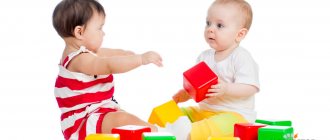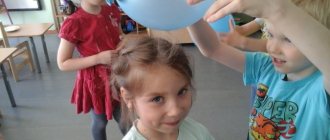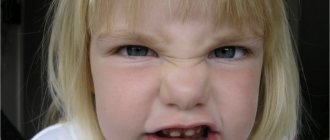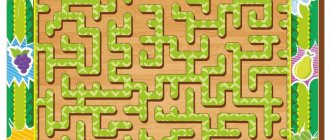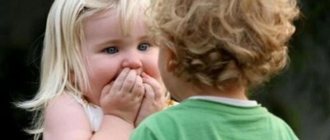Maria Montessori believed that a child's intelligence and knowledge of the world always originate in the senses. Any thought is always preceded by a process of collecting information. This means that the more subtly all the analyzers work, the more chances a person has to solve the problem facing him.
In his book “The Absorbent Mind of the Child,” M. Montessori says that sensory development allows you to open up a whole new world for the baby, making more things and their properties visible, as if someone suddenly turned on the light in a dark room.
It is important to understand that what adults consider obvious, a child has yet to learn: a small stone is lighter than a large stone, but at the same time heavier than a feather, glass is smooth and cold to the touch, and an autumn leaf is warm and rough. A child's absorbent mind is wired for learning, but it is important to place the child in the right environment where he can put his natural curiosity to use.
For more information about Maria Montessori's approach, watch our webinar for parents:
What is sensory development?
Sensory development is the process of forming a child’s perceptions and ideas about the world around him and the properties of objects. Babies do not have developed abstract thinking; they experience life through sensations that underlie the mental and physical development of children.
First, babies learn to distinguish their mother’s voice from strangers, as well as recognize individual sounds, distinguish objects by weight and color; young children do not have access to spatial thinking, they think objectively.
Regular activities with your child will help the correct development of his sensory perception and personality formation.
Senior preschoolers (6–7 years old)
6-7 years is a period when sensory development gains momentum with renewed vigor.
How does this happen? The child becomes more attentive.
He can already control his attention and gaze.
For example, if the attention period of a 4-5 year old child is about 6 minutes, then at 6-7 years old this period will be 10-12 minutes.
But at the same time, such children are not yet able to penetrate into the essence of things; they are still focused on the form.
Another feature of this age is the lack of differentiation of perception. The child sees only superficial information and does not yet know how to penetrate into the essence of things. This is well demonstrated by simple experience. In front of a group of children they placed 2 rows of buttons of the same size, in one row there were seven buttons, in the other 10. In the row where there were 7 buttons, under each of them they placed another one of the same size and shape. Then they asked the kids: “Which row has more buttons?” Almost all children pointed to a row of 10 buttons, since it was visually longer.
In addition, children 6-7 often confuse words that are similar in spelling and sound, but completely different in meaning, for example, “put” and “set up.” This is due to the fact that during this period their analytical function is poorly developed and it is difficult for children to analyze and perceive purposefully and in depth. The visual component still remains a priority at this stage.
As for the perception of time and space, it has its own characteristics in children of this age. They have difficulty processing large periods of time. For example, the period of dinosaurs and 80 years will be perceived by them in exactly the same way, because children do not yet have temporal abstraction.
Attention! At this stage, it is very important for the teacher to teach children to correctly perceive and evaluate spatial and temporal categories and meanings.
The role of sensory development
The main tasks of sensory development of preschoolers include:
- social adaptation of children to the world around them, development of their ability to recognize their sensations and respond correctly to them;
- accumulation of information about various properties of objects (size, color, shape, texture, temperature, sound, etc.);
- development and training of vision, hearing, smell and tactile analyzer in children;
- formation in children of memory, speech, objective thinking and perception of the outside world.
Young children learn life most easily and successfully through play. In the process of education for different ages, many approaches and games are used that can interest kids. This is important for successful classes and progress in sensory education and development of preschoolers.
The main goal of sensory development is to introduce the child to the outside world and the ability to freely navigate it. Children learn to distinguish different objects from each other by weight and shape, become familiar with their texture, learn to listen and distinguish individual sounds and music, and begin to divide colors into warm and cold.
The sensory development of preschool children is represented by several periods. Among them, the periods of 1-2 years and 3-4 years of life are important.
History of Sensory Education in Montessori
Maria Montessori was not the first teacher to draw attention to the importance of developing children's senses. When developing her approach, she relied heavily on the work of the French physician and teacher Edouard Seguin, who at one time worked with children with special needs and created his own system of exercises for developing children’s perceptions and teaching them everyday skills. Jean-Jacques Rousseau and Johann Heinrich Pestalozzi in their works also paid attention to the role of the development of sensory organs in children's learning.
Robert Baden-Powell, founder of the Scout movement and contemporary of Maria Montessori, said that to gain knowledge about the world, children need real experience of interacting with objects. This statement formed the basis of his theory of active learning. He highly valued Maria Montessori's pedagogical approach, noting that if teachers stop commanding and begin to more delicately reinforce a young child's natural need for new experiences, teachers can create a much more solid basis for subsequent learning and development. In his opinion, the idea of education as hard and exhausting work is hopelessly outdated.
Maria Montessori herself began her career working with special needs children who were deprived of adequate sensory stimulation: they had almost no toys, and their whole life was reduced to a series of basic caregiving activities. She was able to clearly prove that changing the living conditions of children significantly changes the level of their abilities. Today, the influence of the environment on a child’s development has been proven at the neurophysiological level. We recommend reading John Medin's book, Rules for Your Child's Brain Development, to become more familiar with this topic.
Maria Montessori created a system of sensory education based on many years of experience observing children and studying the works of outstanding teachers and doctors. Although she was not the first to discover the need for sensory experiences in child development, she was certainly the first educator who was able to draw public attention to this fact.
Sensory development at 1-2 years of age
The development of children 1-2 years old has its own specifics.
At one year and 1-3 months children:
- are able to distinguish between two objects that are different in size and identical in shape, quickly remember words and use them in moments of joy or movement;
- during the game, they reproduce previously learned movements (claps, stringing pyramid rings onto a rod, etc.);
- They begin to orient themselves in space, they can walk and change body position.
At this age, preschoolers perceive square and circle shapes best, as well as some colors (red, blue, green and yellow).
At one year and 3-6 months children:
- begin to distinguish between three objects that are different in size and identical in shape;
- name things and actions at moments of interest;
- among similar objects they can find two identical in meaning and different in other properties;
- learn to distinguish sounds by pitch and rhythm; at the moment of play they can reflect observed actions.
They navigate in space and walk at a side step, stepping over small obstacles.
At one year and 7-9 months children:
- from three or four objects of different shapes, they can choose the same ones according to a sample or the request of their parents;
- begin to understand short stories based on pictures;
- they themselves use two-syllable sentences in their speech;
- During the game they build houses.
Preschoolers begin to better perceive the shape of a triangle, rectangle and oval, as well as some colors (orange, blue, purple).
At one year and 10 months children:
- Based on a sample and a request, they can find two identical objects among objects of different colors;
- understand short stories based on events familiar to them;
- in speech they use simple sentences, use adjectives and pronouns;
- They begin to come up with simple story games (example: a doll dresses a doll).
Closer to three years, children develop ideas about the width, length and height of objects, and they begin to perceive differences in similar sounds.
Reference system for young children
Sensory standards for children at an early stage of development are considered to be:
- nine primary colors of the spectrum;
- five geometric shapes (square, triangle, rectangle, circle, oval);
- three sizes (sizes) of an object: large, medium, small;
- musical notes, sounds of the native language;
- four tastes (sweet, bitter, salty, sour);
- two temperature definitions (warm, cold);
- five types of smell (sweet, bitter, fresh, light, heavy).
Depending on the age of the baby, the requirements of sensory education require the following knowledge and skills.
For ages 1.5-2 years:
- understanding and ability to name 3-4 colors, as well as correctly select them according to the sample;
- orientation in the sizes (magnitudes) of objects, the ability to disassemble and assemble a three-dimensional matryoshka doll;
- the ability to correctly assemble a colored pyramid of 4-6 rings of different sizes;
- the ability to correctly correlate the configuration of three-dimensional figures with flat ones;
- have basic drawing skills (draw horizontal, vertical, short and long lines, and also clearly explain what he drew).
For ages 2-4 years:
- understanding and ability to name 6 colors, as well as correctly select them according to the sample;
- orientation in 3-5 contrasting values (sizes);
- the ability to assemble a colored pyramid of 6-8 rings of different sizes;
- the ability to correctly form a whole object from 4 parts (cut pattern, folding cubes);
- the ability to clearly distinguish between three-dimensional objects in shape (cube, ball, pyramid, etc.) and flat objects in outline (square, triangle, rhombus, circle);
- the ability to draw short and long lines of different locations within a sheet of paper.
Sensory development at 3-4 years of age
By the age of three, preschoolers begin to ask questions “when?”, “who?”, “where?”, “why?”. In their games, they begin to try on roles for themselves and each other (example: the “daughter-mother” game), and in speech they actively use not only simple, but also complex sentences.
They begin to actively draw and transfer into their drawings what they saw earlier. They try to most accurately convey the main features of people, animals and the environment. Young children do not have spatial thinking and the concept of “perspective”, so all the figures on paper are most often the same size (a person is the same size as a house, etc.). Preschoolers cannot comprehend compositions with a lot of detail, so their drawings most often include from one to three figures.
Children's vocabulary increases, they can construct simple and complex sentences using various adjectives and pronouns, they begin to understand the meaning and meaning of words, their emotional connotation.
At the age of three, their knowledge of the color palette is replenished. Kids get acquainted with the concepts of “saturation”, “contrast”, “softness” and learn to distinguish shades of the same color.
Also at this stage of life, children are able to correctly interpret sounds of different character and pitch, they develop a sense of rhythm and understanding of music. They learn to distinguish intonations in the conversations of others and interpret them correctly.
At this age, they begin to study and describe the world around them in more detail and detail, actively touch everything and remember the nature of the surface of objects (smooth, rough, soft, etc.).
The main sensory signs of cognition of the world for children aged 1-4 years are shape, size and color. Their development requires activities that include various games.
The main objectives of the educational methodology
Thanks to the sensory education method, the child learns concepts such as:
- shape and size;
- color and quality;
- taste and smell;
- sound, music.
All this contributes to the flexibility of perception of external factors, speed of analysis, attentiveness, and logic. The importance of these qualities can hardly be overestimated - already from childhood, you can help a child form character traits and develop the abilities necessary for successful self-realization in society and a prosperous career.
Sensory education of preschoolers is necessary in preparation for testing before entering primary school. It was noted that children who received additional training in this area adapted to school much faster and learned new educational materials better.
Games and exercises for sensory development
Children's games for the development of sensory perception take into account all the characteristics of age.
These include:
- interesting but easy to understand stories;
- presence of objects (cubes, sticks, figures);
- multiple repetitions of the material studied in the game;
- pointing and circling gestures;
- active and tactile activities (modeling, drawing, applique, etc.).
Games for training various types of perception (vision, touch, hearing) are based on working with the child’s senses.
"Bag of Secrets"
They take several different small objects (beads, pasta, cereals, etc.), show them to the child, pronounce all the names with him and ask him to remember them. After this, the parents ask him to turn away for a few seconds, during which they need to have time to sort the items into different opaque bags. The child is then asked to determine by touch what exactly is in each bag.
The game is great for training tactile sensations.
"Catch the Animal"
The child is asked to close his eyes, after which they take any plush toy and move it over different parts of his body. Then he is asked to identify and say where exactly the animal “ran” - along the arm, leg, stomach, etc.
The game is quite simple to implement, does not require a large number of props from parents, and is intended for the development and training of the sense of touch.
"Find the patch"
The child is offered several figures to choose from and asked to choose the one that matches the contours of the figure cut out on paper. The game trains vision, touch, logic and spatial thinking in general.
"Fragrant Joy"
They take several identical jars with different scents (creams, scented candles, etc.), give one of them to the child to smell, after which the jars are swapped and asked to determine by the smell which one was given to him earlier.
The game is great for training your sense of smell.
"Find a Pair"
The baby is given several toys that make different sounds and asked to choose the ones that sound the same. The game is suitable for training auditory perception.
"Imitation"
Parents name their child’s emotions (“anger,” “joy,” “sadness”) and accompany them with expressive grimaces. After this, he is called the same emotions and asked to repeat the corresponding grimaces.
All the games described above are an excellent tool in the education of preschoolers and contribute to the harmonious development of their sensory sphere.
